Financial Statement Analysis: Bellamy's Australia Limited Report
VerifiedAdded on 2020/05/28
|11
|2485
|263
Report
AI Summary
This report presents a financial statement analysis of Bellamy's Australia Limited, examining its financial performance, including net losses, working capital, and changes in assets and liabilities. The analysis covers key aspects such as gross profit, income statements, and the impact of share trading suspensions. Furthermore, the report delves into the effectiveness of the continuous disclosure regime in Australia, discussing its principles, regulations, and the importance of accurate and timely information for investors. It explores the implications of selective disclosures and the role of ASIC in monitoring compliance, concluding that the continuous disclosure regime is essential for a strong and efficient market.
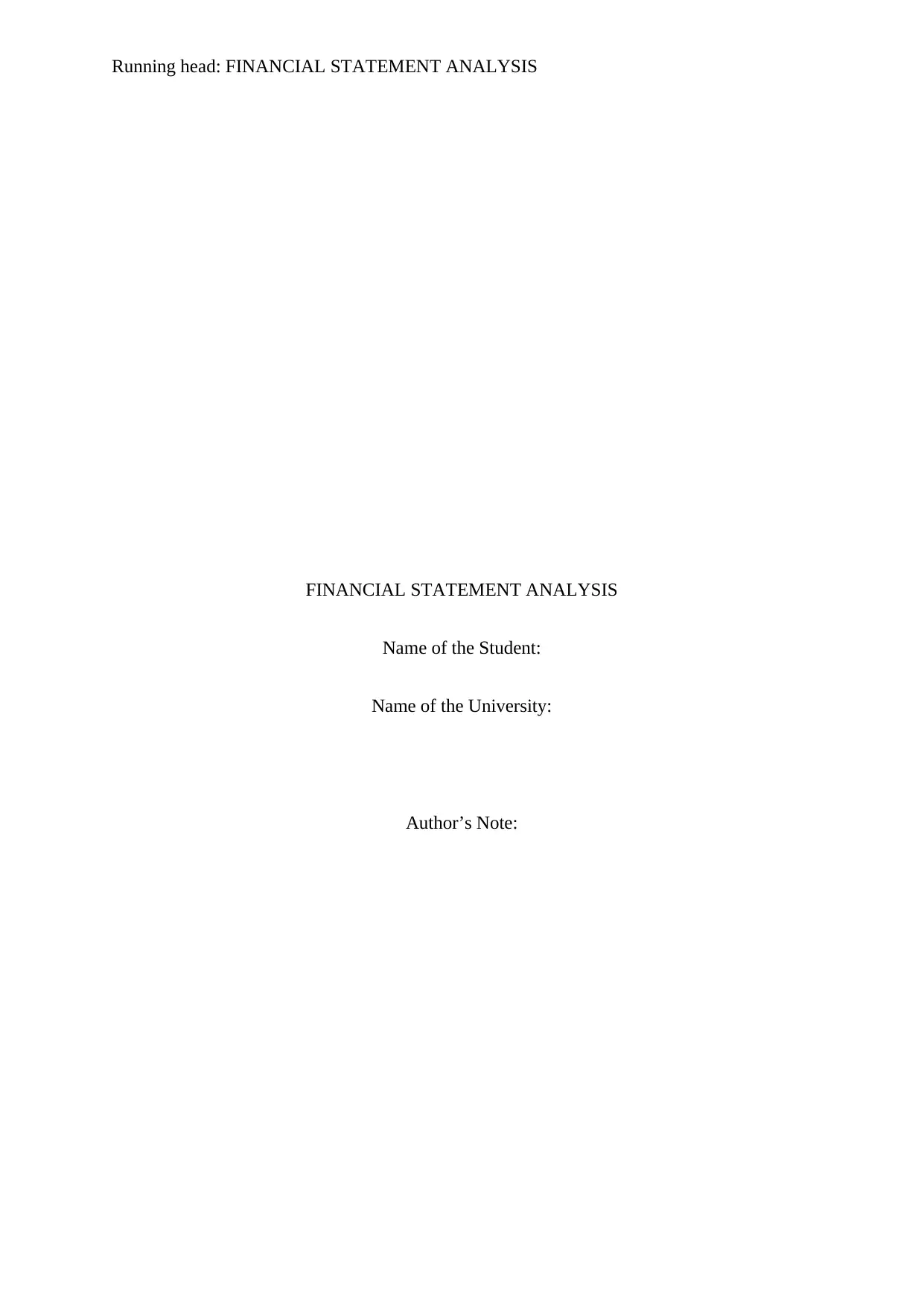
Running head: FINANCIAL STATEMENT ANALYSIS
FINANCIAL STATEMENT ANALYSIS
Name of the Student:
Name of the University:
Author’s Note:
FINANCIAL STATEMENT ANALYSIS
Name of the Student:
Name of the University:
Author’s Note:
Paraphrase This Document
Need a fresh take? Get an instant paraphrase of this document with our AI Paraphraser
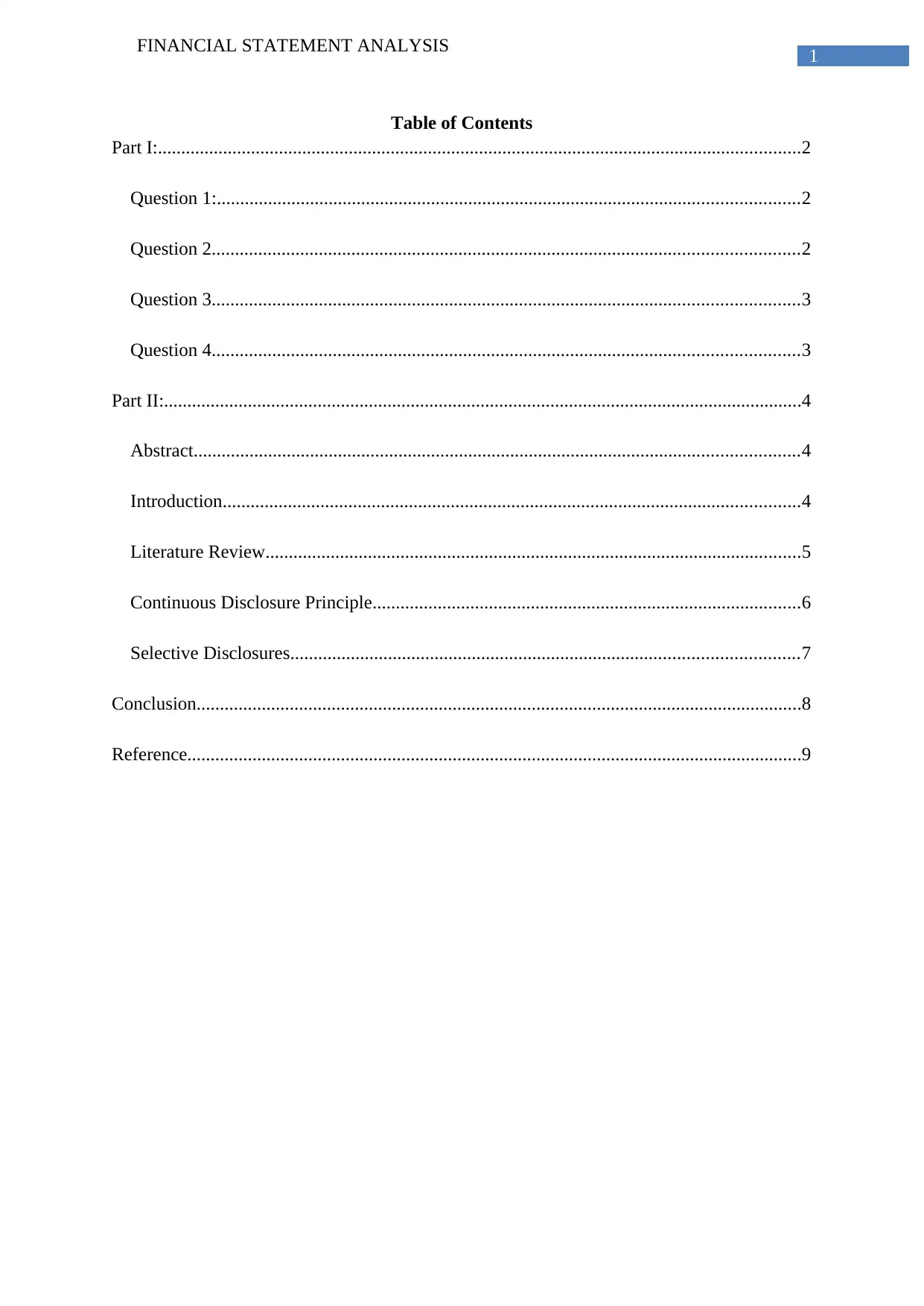
1
FINANCIAL STATEMENT ANALYSIS
Table of Contents
Part I:..........................................................................................................................................2
Question 1:.............................................................................................................................2
Question 2..............................................................................................................................2
Question 3..............................................................................................................................3
Question 4..............................................................................................................................3
Part II:.........................................................................................................................................4
Abstract..................................................................................................................................4
Introduction............................................................................................................................4
Literature Review...................................................................................................................5
Continuous Disclosure Principle............................................................................................6
Selective Disclosures.............................................................................................................7
Conclusion..................................................................................................................................8
Reference....................................................................................................................................9
FINANCIAL STATEMENT ANALYSIS
Table of Contents
Part I:..........................................................................................................................................2
Question 1:.............................................................................................................................2
Question 2..............................................................................................................................2
Question 3..............................................................................................................................3
Question 4..............................................................................................................................3
Part II:.........................................................................................................................................4
Abstract..................................................................................................................................4
Introduction............................................................................................................................4
Literature Review...................................................................................................................5
Continuous Disclosure Principle............................................................................................6
Selective Disclosures.............................................................................................................7
Conclusion..................................................................................................................................8
Reference....................................................................................................................................9
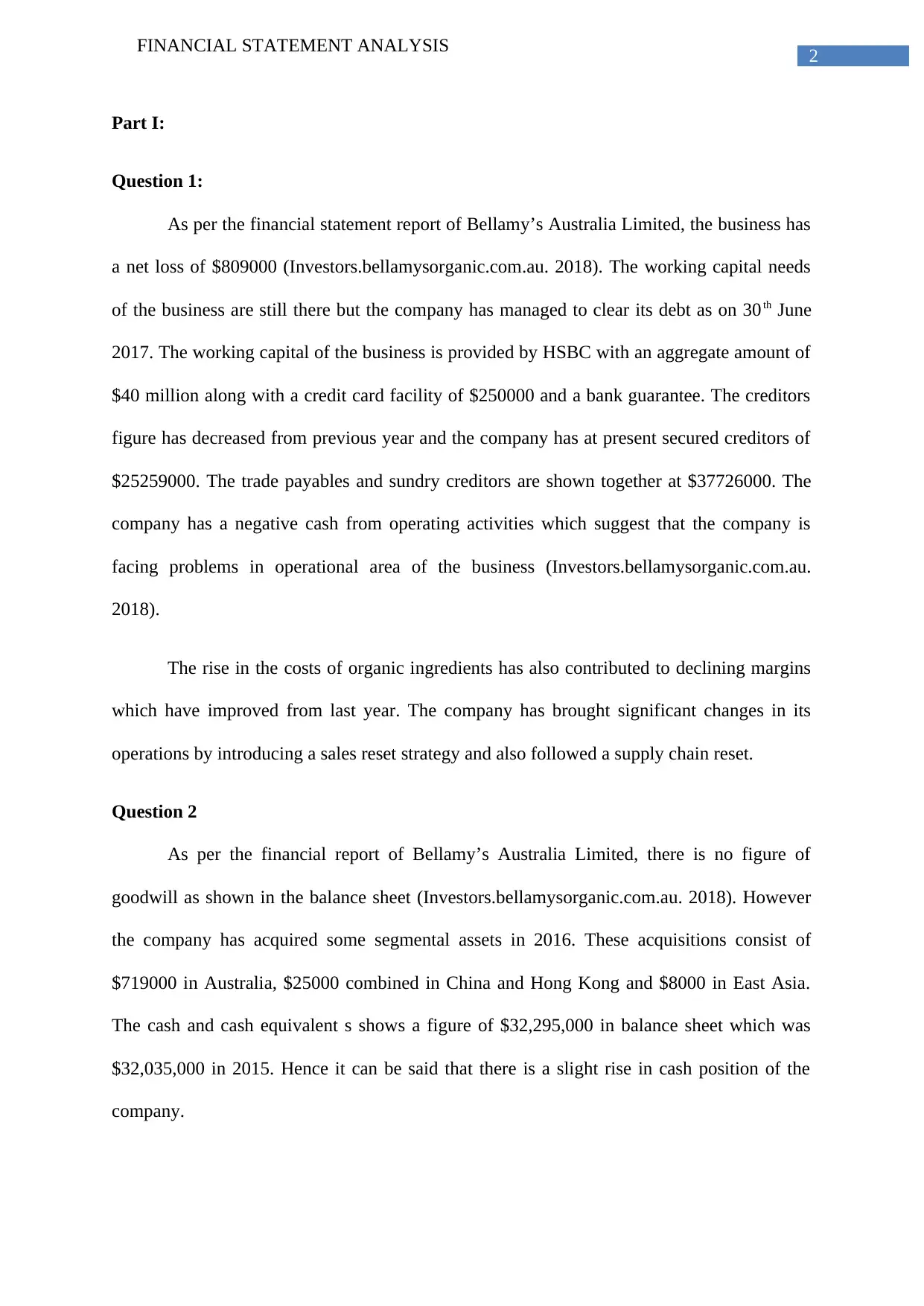
2
FINANCIAL STATEMENT ANALYSIS
Part I:
Question 1:
As per the financial statement report of Bellamy’s Australia Limited, the business has
a net loss of $809000 (Investors.bellamysorganic.com.au. 2018). The working capital needs
of the business are still there but the company has managed to clear its debt as on 30 th June
2017. The working capital of the business is provided by HSBC with an aggregate amount of
$40 million along with a credit card facility of $250000 and a bank guarantee. The creditors
figure has decreased from previous year and the company has at present secured creditors of
$25259000. The trade payables and sundry creditors are shown together at $37726000. The
company has a negative cash from operating activities which suggest that the company is
facing problems in operational area of the business (Investors.bellamysorganic.com.au.
2018).
The rise in the costs of organic ingredients has also contributed to declining margins
which have improved from last year. The company has brought significant changes in its
operations by introducing a sales reset strategy and also followed a supply chain reset.
Question 2
As per the financial report of Bellamy’s Australia Limited, there is no figure of
goodwill as shown in the balance sheet (Investors.bellamysorganic.com.au. 2018). However
the company has acquired some segmental assets in 2016. These acquisitions consist of
$719000 in Australia, $25000 combined in China and Hong Kong and $8000 in East Asia.
The cash and cash equivalent s shows a figure of $32,295,000 in balance sheet which was
$32,035,000 in 2015. Hence it can be said that there is a slight rise in cash position of the
company.
FINANCIAL STATEMENT ANALYSIS
Part I:
Question 1:
As per the financial statement report of Bellamy’s Australia Limited, the business has
a net loss of $809000 (Investors.bellamysorganic.com.au. 2018). The working capital needs
of the business are still there but the company has managed to clear its debt as on 30 th June
2017. The working capital of the business is provided by HSBC with an aggregate amount of
$40 million along with a credit card facility of $250000 and a bank guarantee. The creditors
figure has decreased from previous year and the company has at present secured creditors of
$25259000. The trade payables and sundry creditors are shown together at $37726000. The
company has a negative cash from operating activities which suggest that the company is
facing problems in operational area of the business (Investors.bellamysorganic.com.au.
2018).
The rise in the costs of organic ingredients has also contributed to declining margins
which have improved from last year. The company has brought significant changes in its
operations by introducing a sales reset strategy and also followed a supply chain reset.
Question 2
As per the financial report of Bellamy’s Australia Limited, there is no figure of
goodwill as shown in the balance sheet (Investors.bellamysorganic.com.au. 2018). However
the company has acquired some segmental assets in 2016. These acquisitions consist of
$719000 in Australia, $25000 combined in China and Hong Kong and $8000 in East Asia.
The cash and cash equivalent s shows a figure of $32,295,000 in balance sheet which was
$32,035,000 in 2015. Hence it can be said that there is a slight rise in cash position of the
company.
⊘ This is a preview!⊘
Do you want full access?
Subscribe today to unlock all pages.

Trusted by 1+ million students worldwide
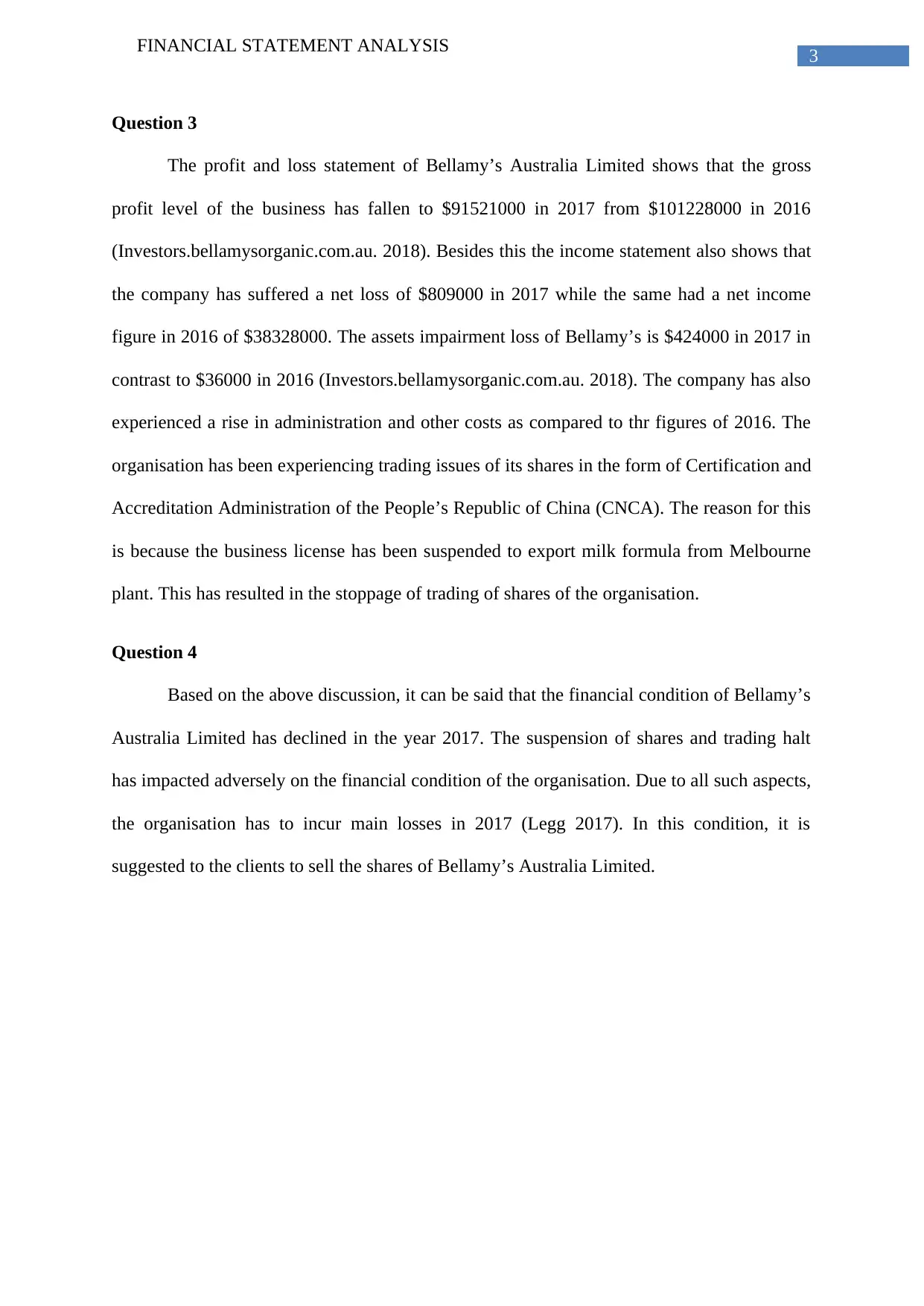
3
FINANCIAL STATEMENT ANALYSIS
Question 3
The profit and loss statement of Bellamy’s Australia Limited shows that the gross
profit level of the business has fallen to $91521000 in 2017 from $101228000 in 2016
(Investors.bellamysorganic.com.au. 2018). Besides this the income statement also shows that
the company has suffered a net loss of $809000 in 2017 while the same had a net income
figure in 2016 of $38328000. The assets impairment loss of Bellamy’s is $424000 in 2017 in
contrast to $36000 in 2016 (Investors.bellamysorganic.com.au. 2018). The company has also
experienced a rise in administration and other costs as compared to thr figures of 2016. The
organisation has been experiencing trading issues of its shares in the form of Certification and
Accreditation Administration of the People’s Republic of China (CNCA). The reason for this
is because the business license has been suspended to export milk formula from Melbourne
plant. This has resulted in the stoppage of trading of shares of the organisation.
Question 4
Based on the above discussion, it can be said that the financial condition of Bellamy’s
Australia Limited has declined in the year 2017. The suspension of shares and trading halt
has impacted adversely on the financial condition of the organisation. Due to all such aspects,
the organisation has to incur main losses in 2017 (Legg 2017). In this condition, it is
suggested to the clients to sell the shares of Bellamy’s Australia Limited.
FINANCIAL STATEMENT ANALYSIS
Question 3
The profit and loss statement of Bellamy’s Australia Limited shows that the gross
profit level of the business has fallen to $91521000 in 2017 from $101228000 in 2016
(Investors.bellamysorganic.com.au. 2018). Besides this the income statement also shows that
the company has suffered a net loss of $809000 in 2017 while the same had a net income
figure in 2016 of $38328000. The assets impairment loss of Bellamy’s is $424000 in 2017 in
contrast to $36000 in 2016 (Investors.bellamysorganic.com.au. 2018). The company has also
experienced a rise in administration and other costs as compared to thr figures of 2016. The
organisation has been experiencing trading issues of its shares in the form of Certification and
Accreditation Administration of the People’s Republic of China (CNCA). The reason for this
is because the business license has been suspended to export milk formula from Melbourne
plant. This has resulted in the stoppage of trading of shares of the organisation.
Question 4
Based on the above discussion, it can be said that the financial condition of Bellamy’s
Australia Limited has declined in the year 2017. The suspension of shares and trading halt
has impacted adversely on the financial condition of the organisation. Due to all such aspects,
the organisation has to incur main losses in 2017 (Legg 2017). In this condition, it is
suggested to the clients to sell the shares of Bellamy’s Australia Limited.
Paraphrase This Document
Need a fresh take? Get an instant paraphrase of this document with our AI Paraphraser
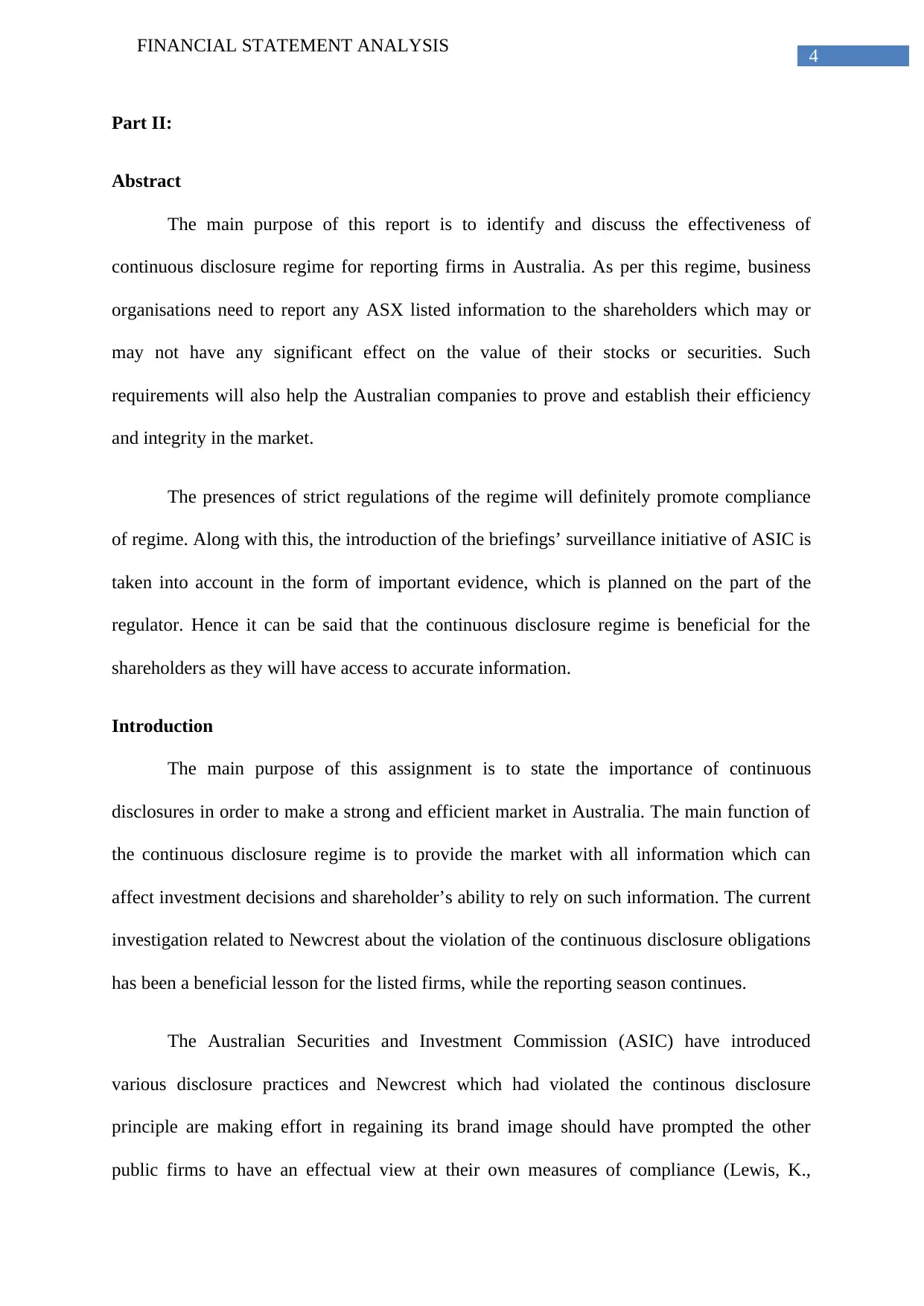
4
FINANCIAL STATEMENT ANALYSIS
Part II:
Abstract
The main purpose of this report is to identify and discuss the effectiveness of
continuous disclosure regime for reporting firms in Australia. As per this regime, business
organisations need to report any ASX listed information to the shareholders which may or
may not have any significant effect on the value of their stocks or securities. Such
requirements will also help the Australian companies to prove and establish their efficiency
and integrity in the market.
The presences of strict regulations of the regime will definitely promote compliance
of regime. Along with this, the introduction of the briefings’ surveillance initiative of ASIC is
taken into account in the form of important evidence, which is planned on the part of the
regulator. Hence it can be said that the continuous disclosure regime is beneficial for the
shareholders as they will have access to accurate information.
Introduction
The main purpose of this assignment is to state the importance of continuous
disclosures in order to make a strong and efficient market in Australia. The main function of
the continuous disclosure regime is to provide the market with all information which can
affect investment decisions and shareholder’s ability to rely on such information. The current
investigation related to Newcrest about the violation of the continuous disclosure obligations
has been a beneficial lesson for the listed firms, while the reporting season continues.
The Australian Securities and Investment Commission (ASIC) have introduced
various disclosure practices and Newcrest which had violated the continous disclosure
principle are making effort in regaining its brand image should have prompted the other
public firms to have an effectual view at their own measures of compliance (Lewis, K.,
FINANCIAL STATEMENT ANALYSIS
Part II:
Abstract
The main purpose of this report is to identify and discuss the effectiveness of
continuous disclosure regime for reporting firms in Australia. As per this regime, business
organisations need to report any ASX listed information to the shareholders which may or
may not have any significant effect on the value of their stocks or securities. Such
requirements will also help the Australian companies to prove and establish their efficiency
and integrity in the market.
The presences of strict regulations of the regime will definitely promote compliance
of regime. Along with this, the introduction of the briefings’ surveillance initiative of ASIC is
taken into account in the form of important evidence, which is planned on the part of the
regulator. Hence it can be said that the continuous disclosure regime is beneficial for the
shareholders as they will have access to accurate information.
Introduction
The main purpose of this assignment is to state the importance of continuous
disclosures in order to make a strong and efficient market in Australia. The main function of
the continuous disclosure regime is to provide the market with all information which can
affect investment decisions and shareholder’s ability to rely on such information. The current
investigation related to Newcrest about the violation of the continuous disclosure obligations
has been a beneficial lesson for the listed firms, while the reporting season continues.
The Australian Securities and Investment Commission (ASIC) have introduced
various disclosure practices and Newcrest which had violated the continous disclosure
principle are making effort in regaining its brand image should have prompted the other
public firms to have an effectual view at their own measures of compliance (Lewis, K.,
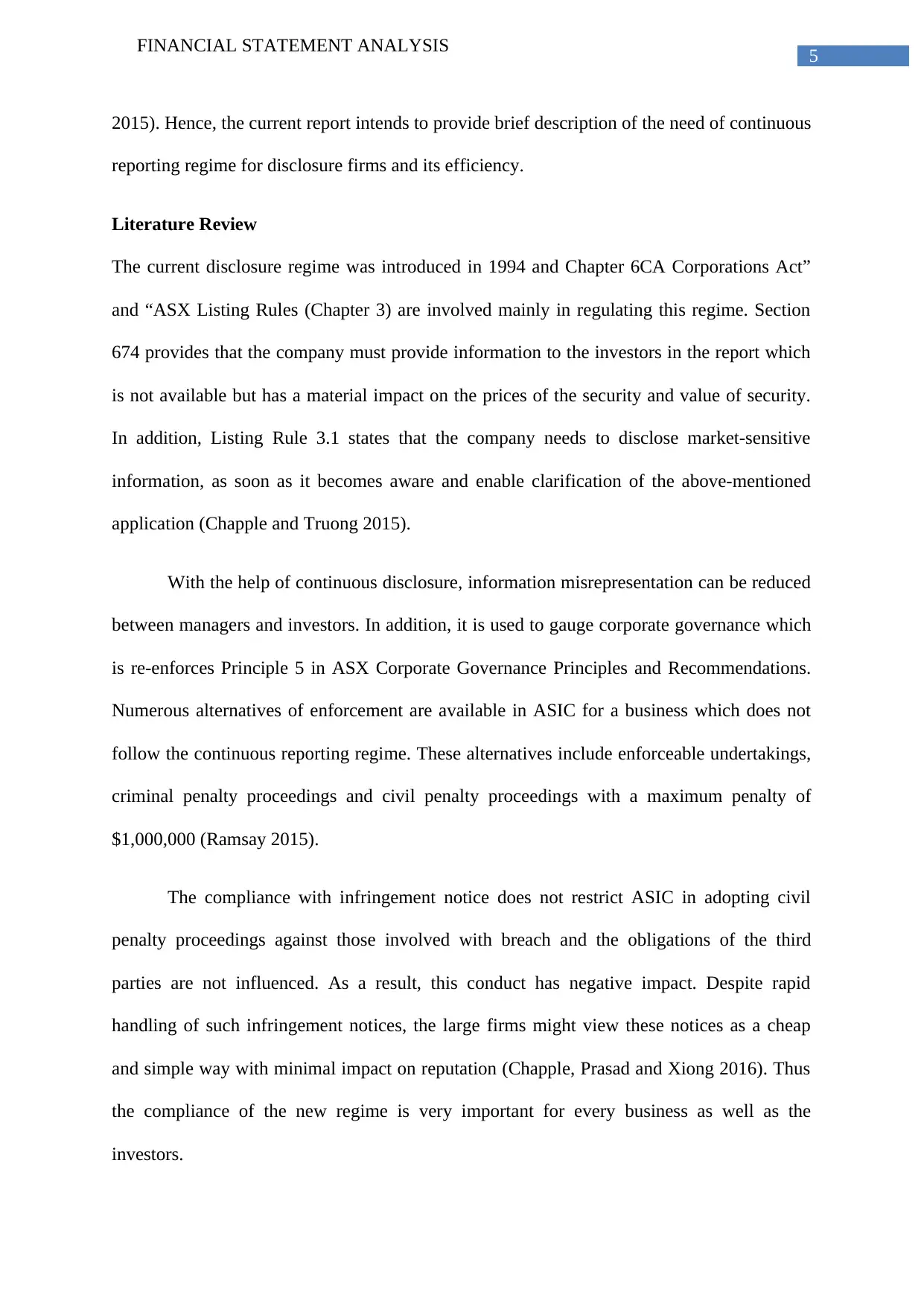
5
FINANCIAL STATEMENT ANALYSIS
2015). Hence, the current report intends to provide brief description of the need of continuous
reporting regime for disclosure firms and its efficiency.
Literature Review
The current disclosure regime was introduced in 1994 and Chapter 6CA Corporations Act”
and “ASX Listing Rules (Chapter 3) are involved mainly in regulating this regime. Section
674 provides that the company must provide information to the investors in the report which
is not available but has a material impact on the prices of the security and value of security.
In addition, Listing Rule 3.1 states that the company needs to disclose market-sensitive
information, as soon as it becomes aware and enable clarification of the above-mentioned
application (Chapple and Truong 2015).
With the help of continuous disclosure, information misrepresentation can be reduced
between managers and investors. In addition, it is used to gauge corporate governance which
is re-enforces Principle 5 in ASX Corporate Governance Principles and Recommendations.
Numerous alternatives of enforcement are available in ASIC for a business which does not
follow the continuous reporting regime. These alternatives include enforceable undertakings,
criminal penalty proceedings and civil penalty proceedings with a maximum penalty of
$1,000,000 (Ramsay 2015).
The compliance with infringement notice does not restrict ASIC in adopting civil
penalty proceedings against those involved with breach and the obligations of the third
parties are not influenced. As a result, this conduct has negative impact. Despite rapid
handling of such infringement notices, the large firms might view these notices as a cheap
and simple way with minimal impact on reputation (Chapple, Prasad and Xiong 2016). Thus
the compliance of the new regime is very important for every business as well as the
investors.
FINANCIAL STATEMENT ANALYSIS
2015). Hence, the current report intends to provide brief description of the need of continuous
reporting regime for disclosure firms and its efficiency.
Literature Review
The current disclosure regime was introduced in 1994 and Chapter 6CA Corporations Act”
and “ASX Listing Rules (Chapter 3) are involved mainly in regulating this regime. Section
674 provides that the company must provide information to the investors in the report which
is not available but has a material impact on the prices of the security and value of security.
In addition, Listing Rule 3.1 states that the company needs to disclose market-sensitive
information, as soon as it becomes aware and enable clarification of the above-mentioned
application (Chapple and Truong 2015).
With the help of continuous disclosure, information misrepresentation can be reduced
between managers and investors. In addition, it is used to gauge corporate governance which
is re-enforces Principle 5 in ASX Corporate Governance Principles and Recommendations.
Numerous alternatives of enforcement are available in ASIC for a business which does not
follow the continuous reporting regime. These alternatives include enforceable undertakings,
criminal penalty proceedings and civil penalty proceedings with a maximum penalty of
$1,000,000 (Ramsay 2015).
The compliance with infringement notice does not restrict ASIC in adopting civil
penalty proceedings against those involved with breach and the obligations of the third
parties are not influenced. As a result, this conduct has negative impact. Despite rapid
handling of such infringement notices, the large firms might view these notices as a cheap
and simple way with minimal impact on reputation (Chapple, Prasad and Xiong 2016). Thus
the compliance of the new regime is very important for every business as well as the
investors.
⊘ This is a preview!⊘
Do you want full access?
Subscribe today to unlock all pages.

Trusted by 1+ million students worldwide
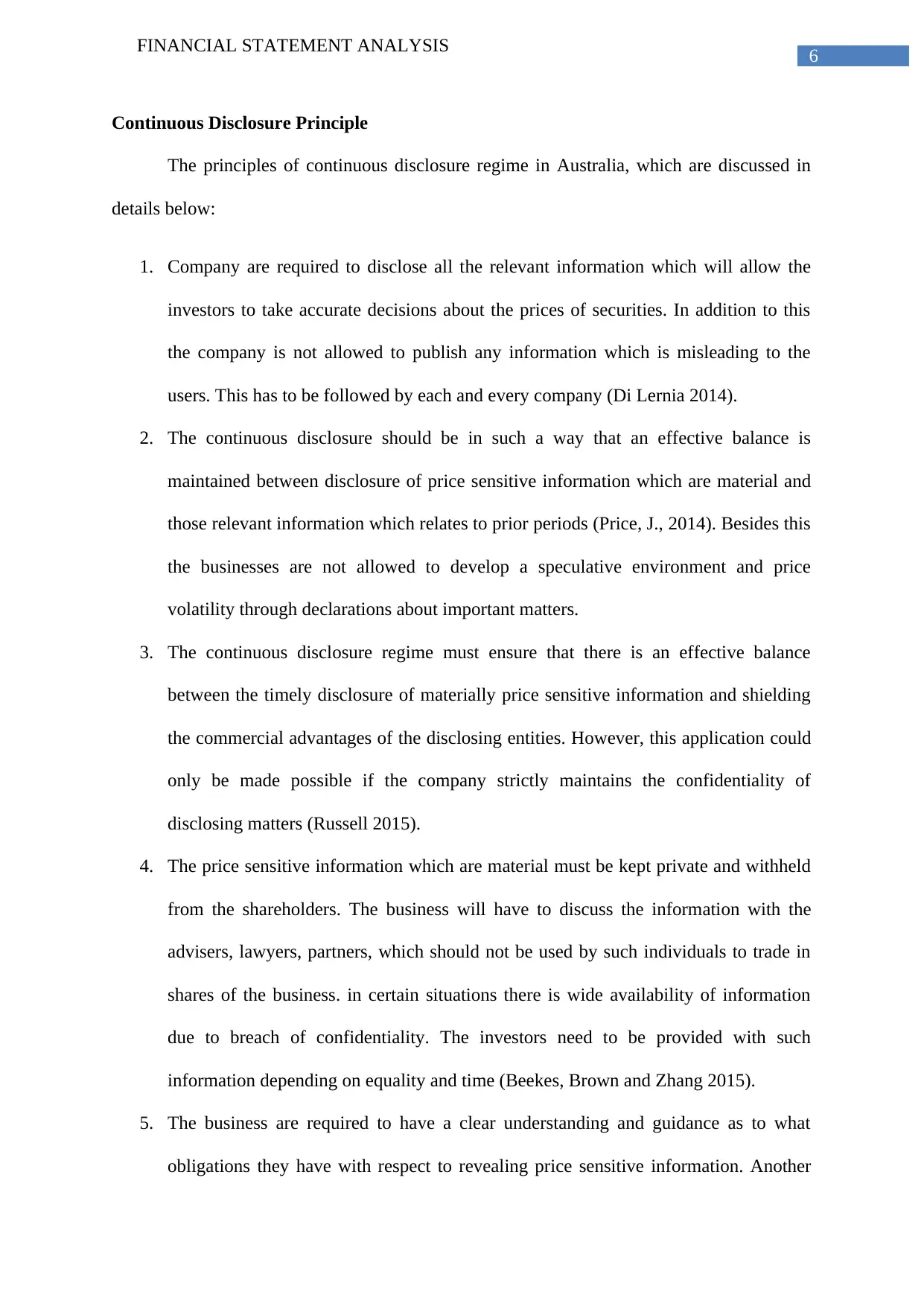
6
FINANCIAL STATEMENT ANALYSIS
Continuous Disclosure Principle
The principles of continuous disclosure regime in Australia, which are discussed in
details below:
1. Company are required to disclose all the relevant information which will allow the
investors to take accurate decisions about the prices of securities. In addition to this
the company is not allowed to publish any information which is misleading to the
users. This has to be followed by each and every company (Di Lernia 2014).
2. The continuous disclosure should be in such a way that an effective balance is
maintained between disclosure of price sensitive information which are material and
those relevant information which relates to prior periods (Price, J., 2014). Besides this
the businesses are not allowed to develop a speculative environment and price
volatility through declarations about important matters.
3. The continuous disclosure regime must ensure that there is an effective balance
between the timely disclosure of materially price sensitive information and shielding
the commercial advantages of the disclosing entities. However, this application could
only be made possible if the company strictly maintains the confidentiality of
disclosing matters (Russell 2015).
4. The price sensitive information which are material must be kept private and withheld
from the shareholders. The business will have to discuss the information with the
advisers, lawyers, partners, which should not be used by such individuals to trade in
shares of the business. in certain situations there is wide availability of information
due to breach of confidentiality. The investors need to be provided with such
information depending on equality and time (Beekes, Brown and Zhang 2015).
5. The business are required to have a clear understanding and guidance as to what
obligations they have with respect to revealing price sensitive information. Another
FINANCIAL STATEMENT ANALYSIS
Continuous Disclosure Principle
The principles of continuous disclosure regime in Australia, which are discussed in
details below:
1. Company are required to disclose all the relevant information which will allow the
investors to take accurate decisions about the prices of securities. In addition to this
the company is not allowed to publish any information which is misleading to the
users. This has to be followed by each and every company (Di Lernia 2014).
2. The continuous disclosure should be in such a way that an effective balance is
maintained between disclosure of price sensitive information which are material and
those relevant information which relates to prior periods (Price, J., 2014). Besides this
the businesses are not allowed to develop a speculative environment and price
volatility through declarations about important matters.
3. The continuous disclosure regime must ensure that there is an effective balance
between the timely disclosure of materially price sensitive information and shielding
the commercial advantages of the disclosing entities. However, this application could
only be made possible if the company strictly maintains the confidentiality of
disclosing matters (Russell 2015).
4. The price sensitive information which are material must be kept private and withheld
from the shareholders. The business will have to discuss the information with the
advisers, lawyers, partners, which should not be used by such individuals to trade in
shares of the business. in certain situations there is wide availability of information
due to breach of confidentiality. The investors need to be provided with such
information depending on equality and time (Beekes, Brown and Zhang 2015).
5. The business are required to have a clear understanding and guidance as to what
obligations they have with respect to revealing price sensitive information. Another
Paraphrase This Document
Need a fresh take? Get an instant paraphrase of this document with our AI Paraphraser
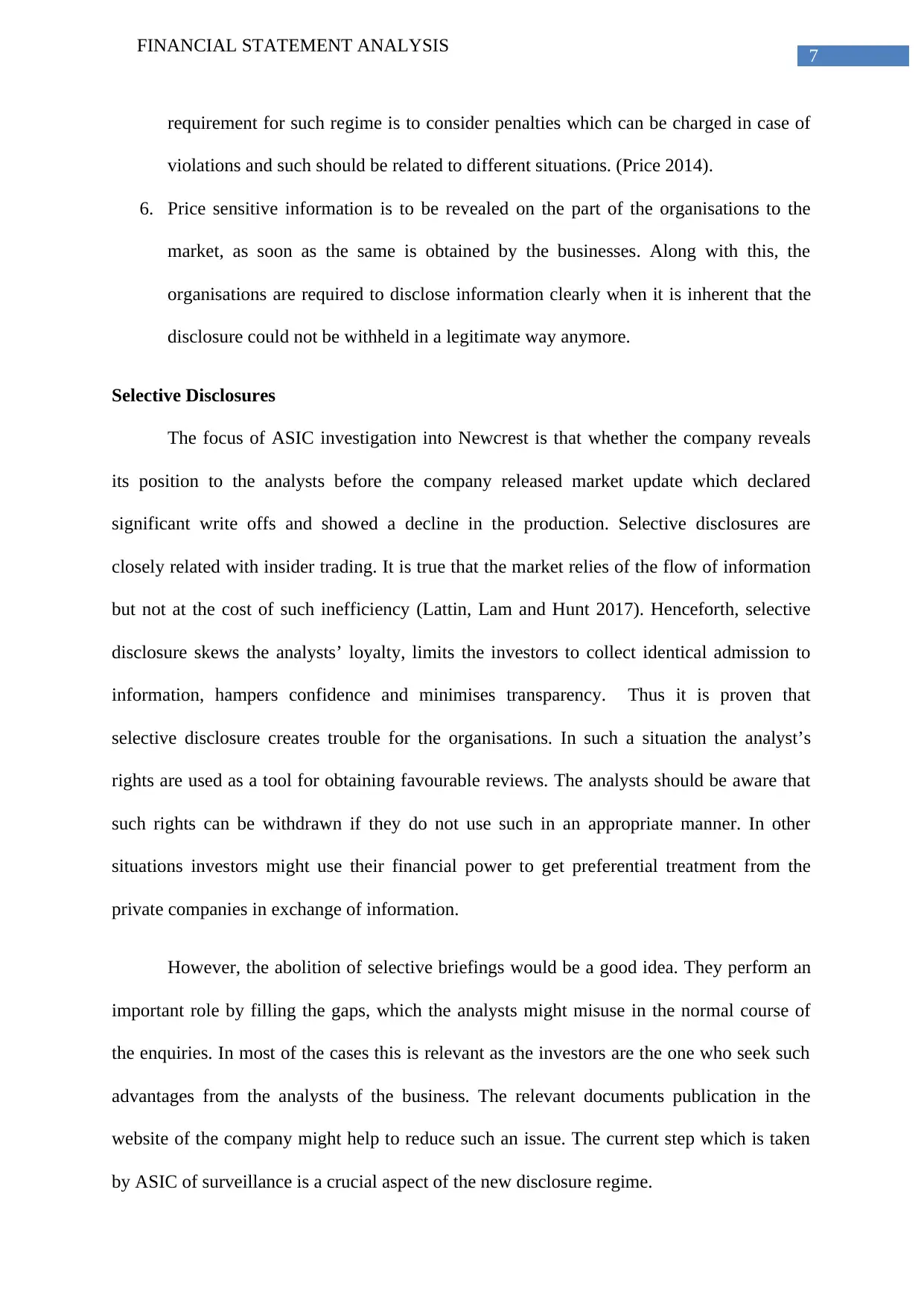
7
FINANCIAL STATEMENT ANALYSIS
requirement for such regime is to consider penalties which can be charged in case of
violations and such should be related to different situations. (Price 2014).
6. Price sensitive information is to be revealed on the part of the organisations to the
market, as soon as the same is obtained by the businesses. Along with this, the
organisations are required to disclose information clearly when it is inherent that the
disclosure could not be withheld in a legitimate way anymore.
Selective Disclosures
The focus of ASIC investigation into Newcrest is that whether the company reveals
its position to the analysts before the company released market update which declared
significant write offs and showed a decline in the production. Selective disclosures are
closely related with insider trading. It is true that the market relies of the flow of information
but not at the cost of such inefficiency (Lattin, Lam and Hunt 2017). Henceforth, selective
disclosure skews the analysts’ loyalty, limits the investors to collect identical admission to
information, hampers confidence and minimises transparency. Thus it is proven that
selective disclosure creates trouble for the organisations. In such a situation the analyst’s
rights are used as a tool for obtaining favourable reviews. The analysts should be aware that
such rights can be withdrawn if they do not use such in an appropriate manner. In other
situations investors might use their financial power to get preferential treatment from the
private companies in exchange of information.
However, the abolition of selective briefings would be a good idea. They perform an
important role by filling the gaps, which the analysts might misuse in the normal course of
the enquiries. In most of the cases this is relevant as the investors are the one who seek such
advantages from the analysts of the business. The relevant documents publication in the
website of the company might help to reduce such an issue. The current step which is taken
by ASIC of surveillance is a crucial aspect of the new disclosure regime.
FINANCIAL STATEMENT ANALYSIS
requirement for such regime is to consider penalties which can be charged in case of
violations and such should be related to different situations. (Price 2014).
6. Price sensitive information is to be revealed on the part of the organisations to the
market, as soon as the same is obtained by the businesses. Along with this, the
organisations are required to disclose information clearly when it is inherent that the
disclosure could not be withheld in a legitimate way anymore.
Selective Disclosures
The focus of ASIC investigation into Newcrest is that whether the company reveals
its position to the analysts before the company released market update which declared
significant write offs and showed a decline in the production. Selective disclosures are
closely related with insider trading. It is true that the market relies of the flow of information
but not at the cost of such inefficiency (Lattin, Lam and Hunt 2017). Henceforth, selective
disclosure skews the analysts’ loyalty, limits the investors to collect identical admission to
information, hampers confidence and minimises transparency. Thus it is proven that
selective disclosure creates trouble for the organisations. In such a situation the analyst’s
rights are used as a tool for obtaining favourable reviews. The analysts should be aware that
such rights can be withdrawn if they do not use such in an appropriate manner. In other
situations investors might use their financial power to get preferential treatment from the
private companies in exchange of information.
However, the abolition of selective briefings would be a good idea. They perform an
important role by filling the gaps, which the analysts might misuse in the normal course of
the enquiries. In most of the cases this is relevant as the investors are the one who seek such
advantages from the analysts of the business. The relevant documents publication in the
website of the company might help to reduce such an issue. The current step which is taken
by ASIC of surveillance is a crucial aspect of the new disclosure regime.
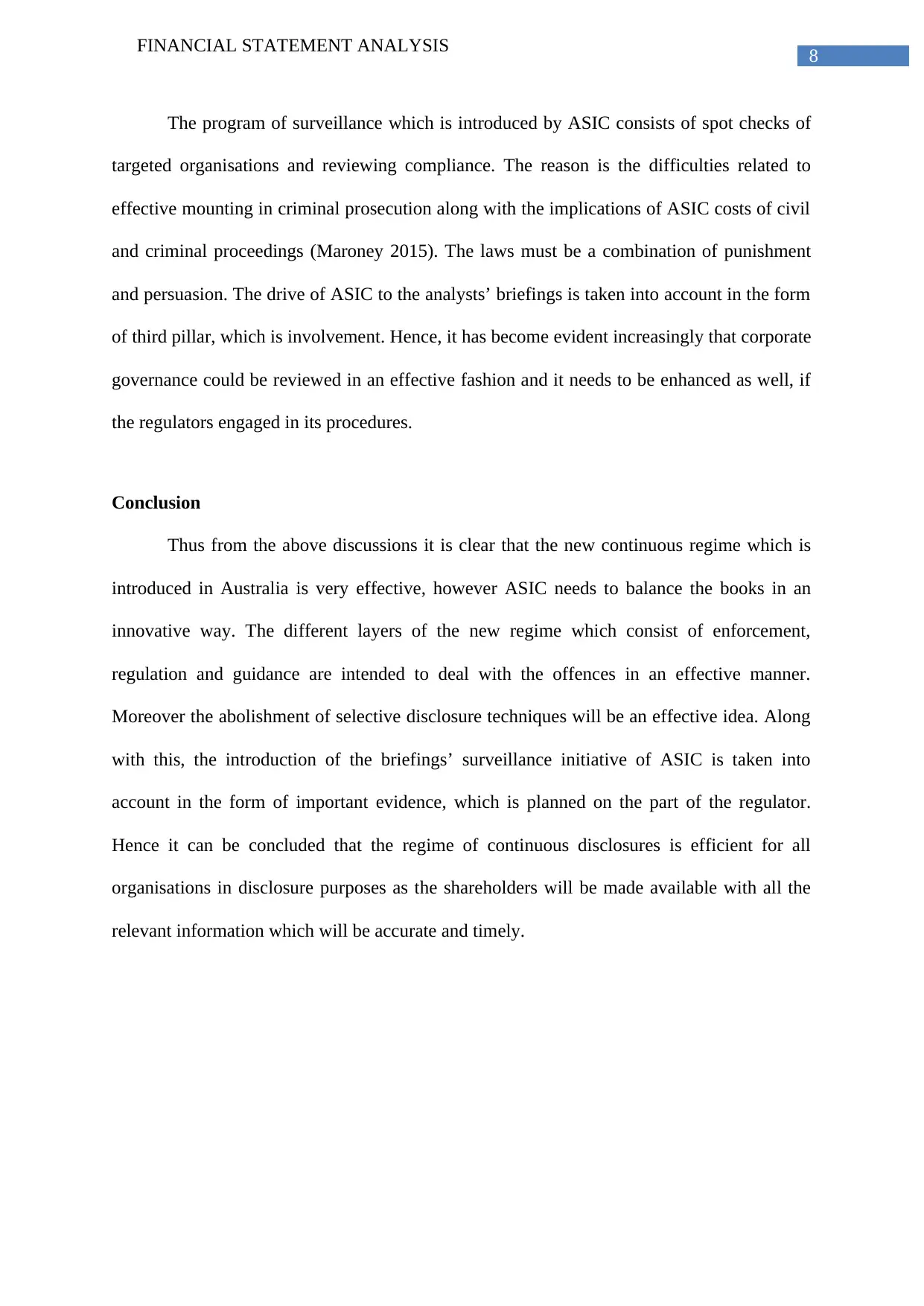
8
FINANCIAL STATEMENT ANALYSIS
The program of surveillance which is introduced by ASIC consists of spot checks of
targeted organisations and reviewing compliance. The reason is the difficulties related to
effective mounting in criminal prosecution along with the implications of ASIC costs of civil
and criminal proceedings (Maroney 2015). The laws must be a combination of punishment
and persuasion. The drive of ASIC to the analysts’ briefings is taken into account in the form
of third pillar, which is involvement. Hence, it has become evident increasingly that corporate
governance could be reviewed in an effective fashion and it needs to be enhanced as well, if
the regulators engaged in its procedures.
Conclusion
Thus from the above discussions it is clear that the new continuous regime which is
introduced in Australia is very effective, however ASIC needs to balance the books in an
innovative way. The different layers of the new regime which consist of enforcement,
regulation and guidance are intended to deal with the offences in an effective manner.
Moreover the abolishment of selective disclosure techniques will be an effective idea. Along
with this, the introduction of the briefings’ surveillance initiative of ASIC is taken into
account in the form of important evidence, which is planned on the part of the regulator.
Hence it can be concluded that the regime of continuous disclosures is efficient for all
organisations in disclosure purposes as the shareholders will be made available with all the
relevant information which will be accurate and timely.
FINANCIAL STATEMENT ANALYSIS
The program of surveillance which is introduced by ASIC consists of spot checks of
targeted organisations and reviewing compliance. The reason is the difficulties related to
effective mounting in criminal prosecution along with the implications of ASIC costs of civil
and criminal proceedings (Maroney 2015). The laws must be a combination of punishment
and persuasion. The drive of ASIC to the analysts’ briefings is taken into account in the form
of third pillar, which is involvement. Hence, it has become evident increasingly that corporate
governance could be reviewed in an effective fashion and it needs to be enhanced as well, if
the regulators engaged in its procedures.
Conclusion
Thus from the above discussions it is clear that the new continuous regime which is
introduced in Australia is very effective, however ASIC needs to balance the books in an
innovative way. The different layers of the new regime which consist of enforcement,
regulation and guidance are intended to deal with the offences in an effective manner.
Moreover the abolishment of selective disclosure techniques will be an effective idea. Along
with this, the introduction of the briefings’ surveillance initiative of ASIC is taken into
account in the form of important evidence, which is planned on the part of the regulator.
Hence it can be concluded that the regime of continuous disclosures is efficient for all
organisations in disclosure purposes as the shareholders will be made available with all the
relevant information which will be accurate and timely.
⊘ This is a preview!⊘
Do you want full access?
Subscribe today to unlock all pages.

Trusted by 1+ million students worldwide
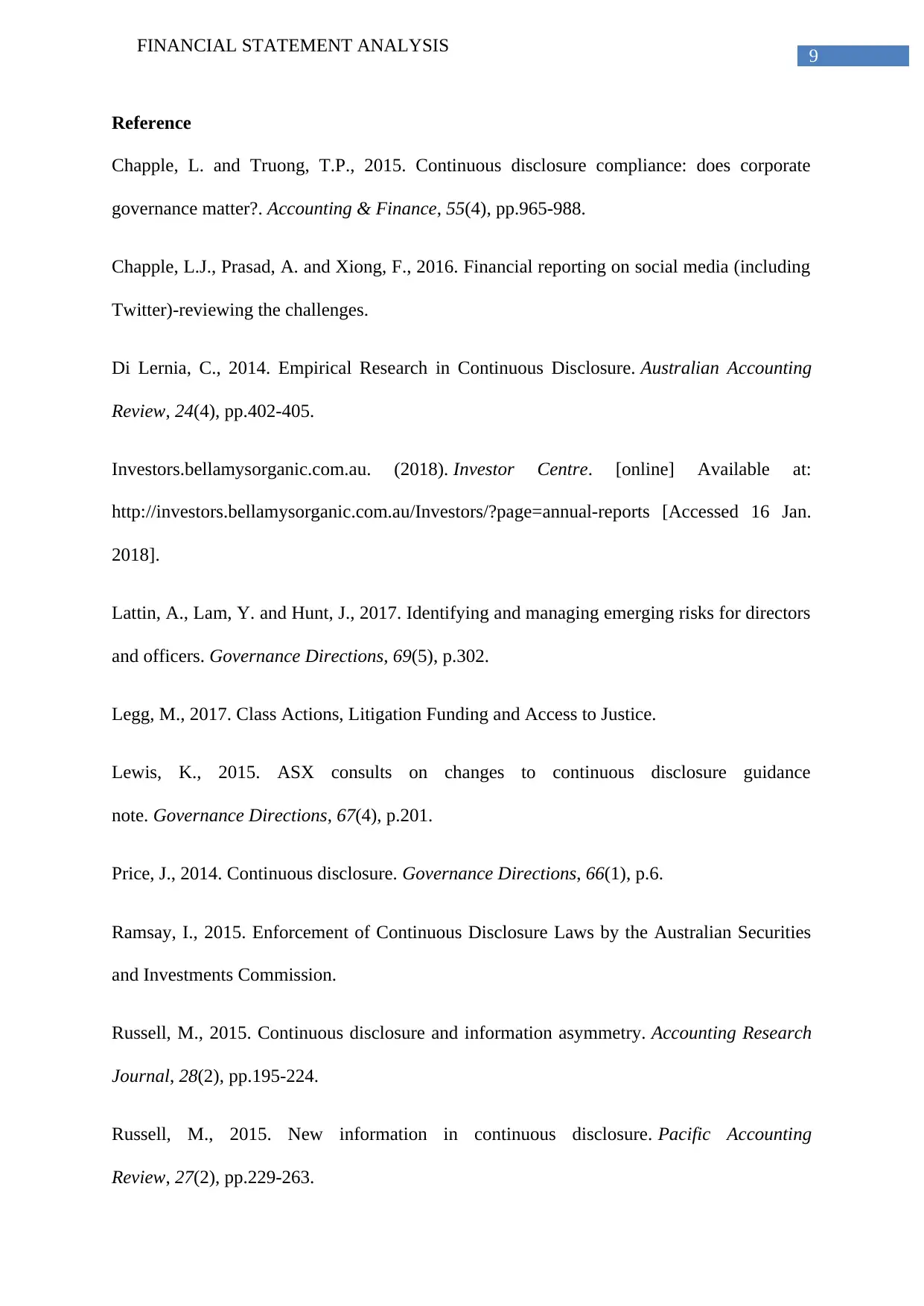
9
FINANCIAL STATEMENT ANALYSIS
Reference
Chapple, L. and Truong, T.P., 2015. Continuous disclosure compliance: does corporate
governance matter?. Accounting & Finance, 55(4), pp.965-988.
Chapple, L.J., Prasad, A. and Xiong, F., 2016. Financial reporting on social media (including
Twitter)-reviewing the challenges.
Di Lernia, C., 2014. Empirical Research in Continuous Disclosure. Australian Accounting
Review, 24(4), pp.402-405.
Investors.bellamysorganic.com.au. (2018). Investor Centre. [online] Available at:
http://investors.bellamysorganic.com.au/Investors/?page=annual-reports [Accessed 16 Jan.
2018].
Lattin, A., Lam, Y. and Hunt, J., 2017. Identifying and managing emerging risks for directors
and officers. Governance Directions, 69(5), p.302.
Legg, M., 2017. Class Actions, Litigation Funding and Access to Justice.
Lewis, K., 2015. ASX consults on changes to continuous disclosure guidance
note. Governance Directions, 67(4), p.201.
Price, J., 2014. Continuous disclosure. Governance Directions, 66(1), p.6.
Ramsay, I., 2015. Enforcement of Continuous Disclosure Laws by the Australian Securities
and Investments Commission.
Russell, M., 2015. Continuous disclosure and information asymmetry. Accounting Research
Journal, 28(2), pp.195-224.
Russell, M., 2015. New information in continuous disclosure. Pacific Accounting
Review, 27(2), pp.229-263.
FINANCIAL STATEMENT ANALYSIS
Reference
Chapple, L. and Truong, T.P., 2015. Continuous disclosure compliance: does corporate
governance matter?. Accounting & Finance, 55(4), pp.965-988.
Chapple, L.J., Prasad, A. and Xiong, F., 2016. Financial reporting on social media (including
Twitter)-reviewing the challenges.
Di Lernia, C., 2014. Empirical Research in Continuous Disclosure. Australian Accounting
Review, 24(4), pp.402-405.
Investors.bellamysorganic.com.au. (2018). Investor Centre. [online] Available at:
http://investors.bellamysorganic.com.au/Investors/?page=annual-reports [Accessed 16 Jan.
2018].
Lattin, A., Lam, Y. and Hunt, J., 2017. Identifying and managing emerging risks for directors
and officers. Governance Directions, 69(5), p.302.
Legg, M., 2017. Class Actions, Litigation Funding and Access to Justice.
Lewis, K., 2015. ASX consults on changes to continuous disclosure guidance
note. Governance Directions, 67(4), p.201.
Price, J., 2014. Continuous disclosure. Governance Directions, 66(1), p.6.
Ramsay, I., 2015. Enforcement of Continuous Disclosure Laws by the Australian Securities
and Investments Commission.
Russell, M., 2015. Continuous disclosure and information asymmetry. Accounting Research
Journal, 28(2), pp.195-224.
Russell, M., 2015. New information in continuous disclosure. Pacific Accounting
Review, 27(2), pp.229-263.
Paraphrase This Document
Need a fresh take? Get an instant paraphrase of this document with our AI Paraphraser
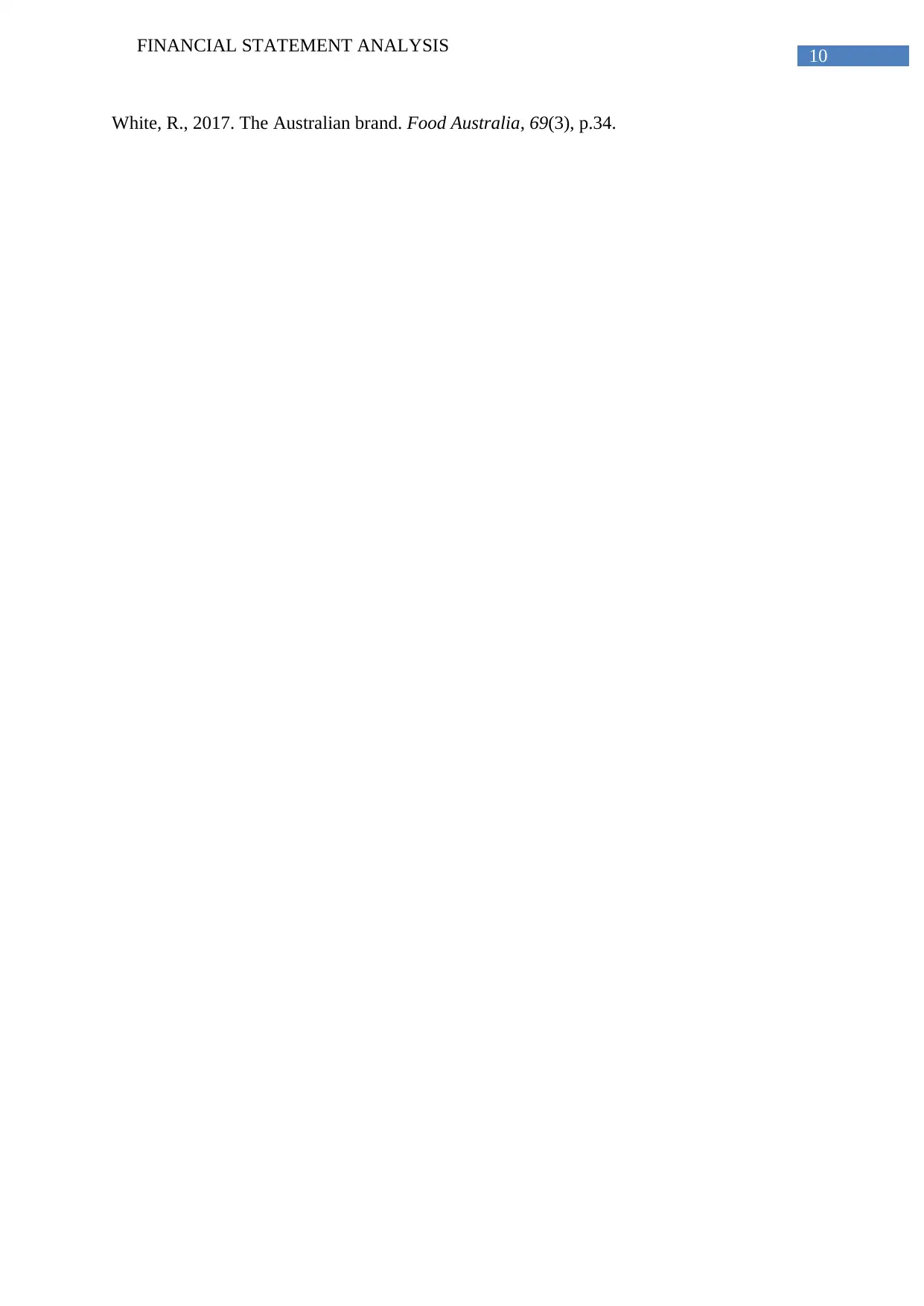
10
FINANCIAL STATEMENT ANALYSIS
White, R., 2017. The Australian brand. Food Australia, 69(3), p.34.
FINANCIAL STATEMENT ANALYSIS
White, R., 2017. The Australian brand. Food Australia, 69(3), p.34.
1 out of 11
Related Documents
Your All-in-One AI-Powered Toolkit for Academic Success.
+13062052269
info@desklib.com
Available 24*7 on WhatsApp / Email
![[object Object]](/_next/static/media/star-bottom.7253800d.svg)
Unlock your academic potential
Copyright © 2020–2025 A2Z Services. All Rights Reserved. Developed and managed by ZUCOL.





